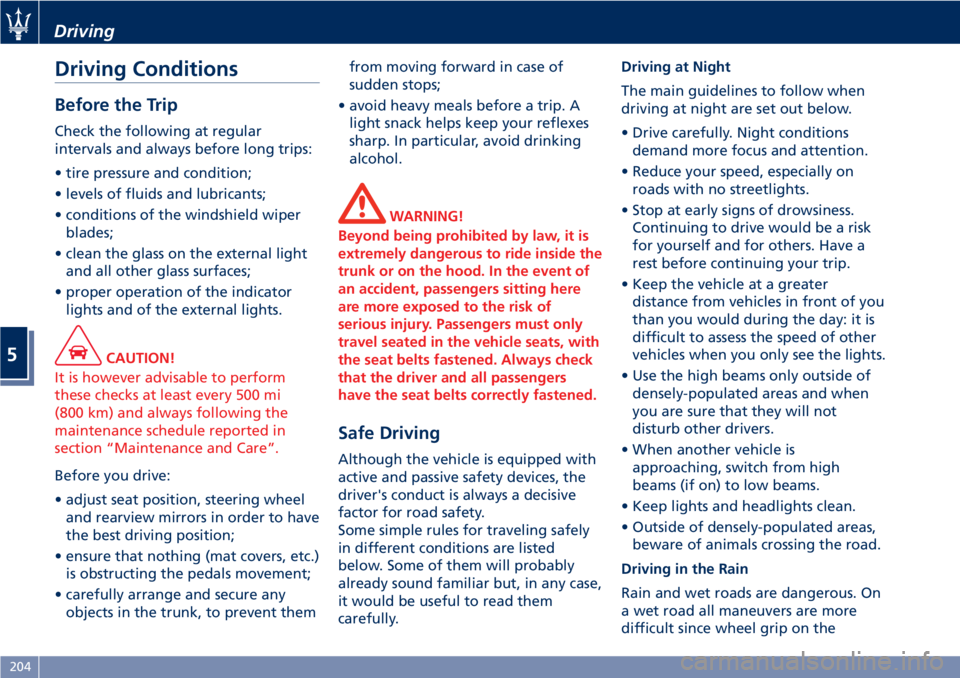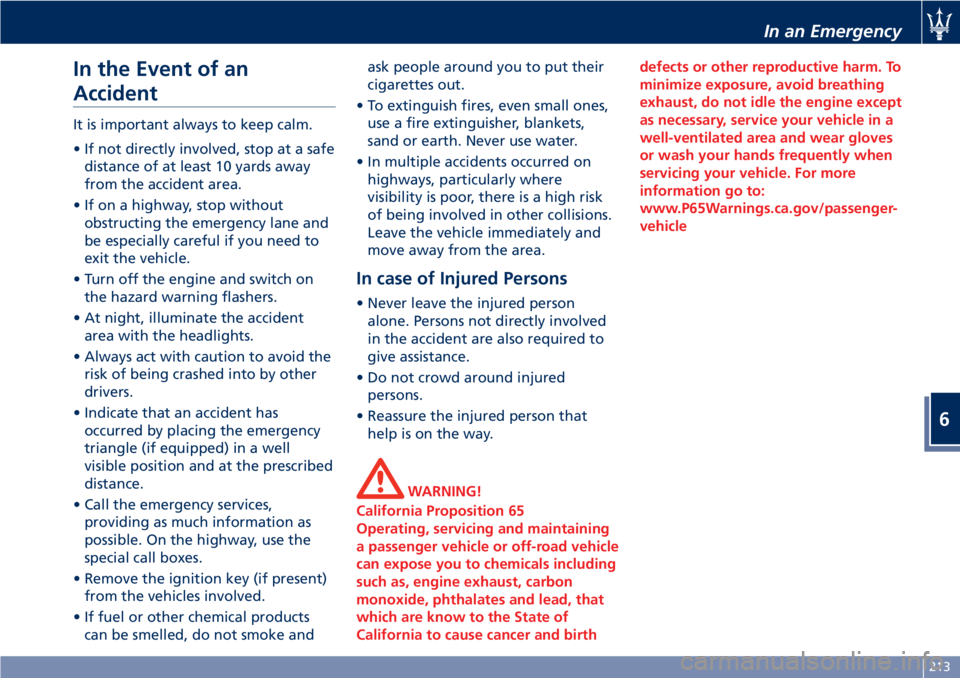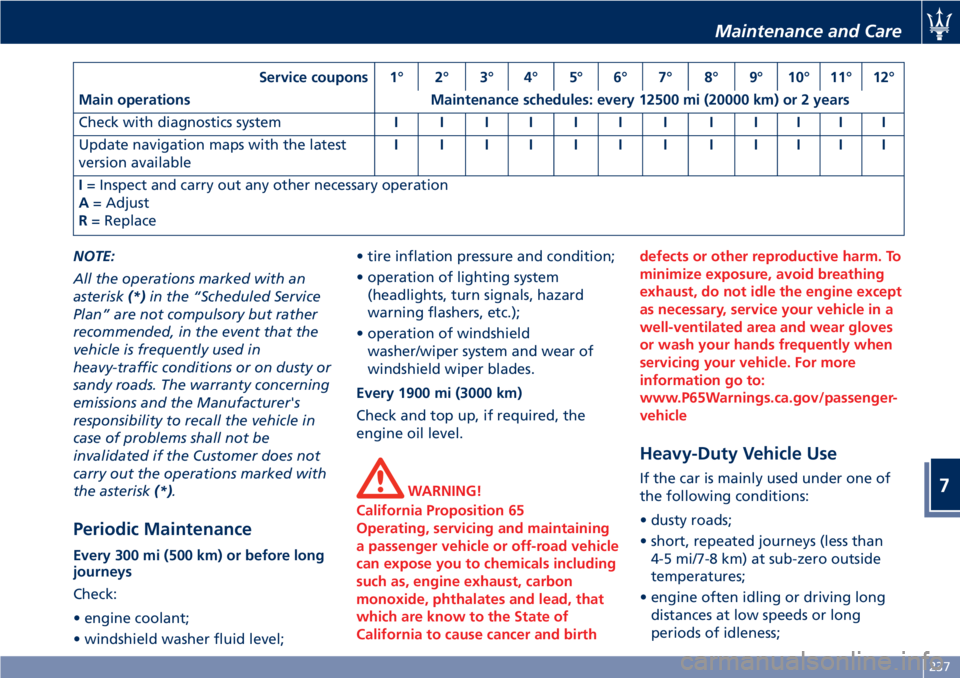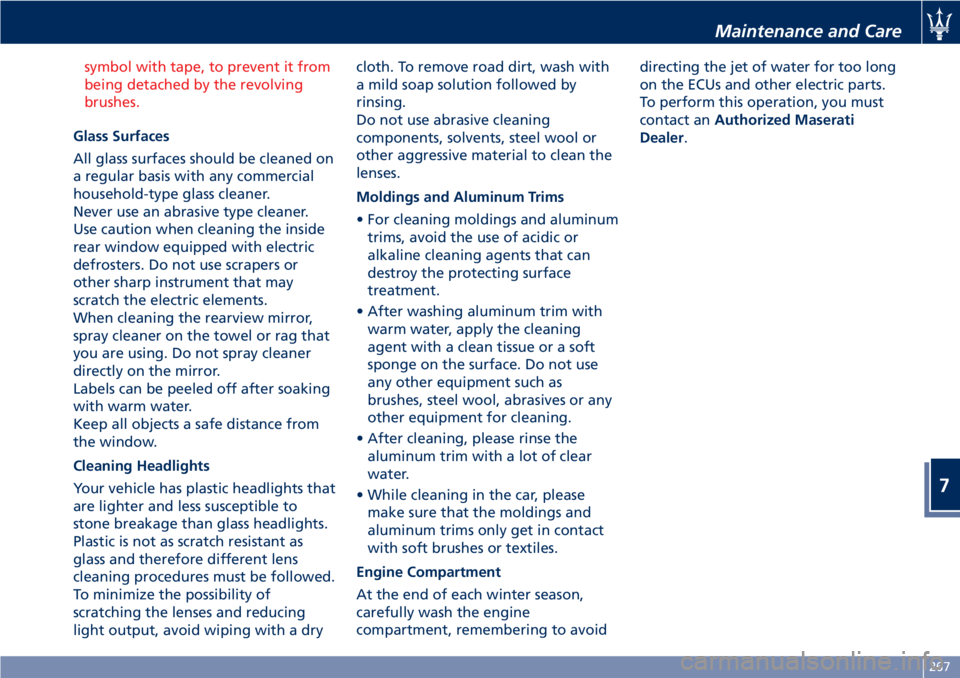2020 MASERATI GRANTURISMO CONVERTIBLE headlights
[x] Cancel search: headlightsPage 162 of 296

Normal Starting of the
Engine
WARNING!
It is dangerous to run the engine in an
enclosed area. The engine consumes
oxygen and discharges carbon
dioxide, carbon monoxide and other
toxic gases in the atmosphere.
WARNING!
California Proposition 65
Operating, servicing and maintaining
a passenger vehicle or off-road vehicle
can expose you to chemicals including
such as, engine exhaust, carbon
monoxide, phthalates and lead, that
which are know to the State of
California to cause cancer and birth
defects or other reproductive harm. To
minimize exposure, avoid breathing
exhaust, do not idle the engine except
as necessary, service your vehicle in a
well-ventilated area and wear gloves
or wash your hands frequently when
servicing your vehicle. For more
information go to:www.P65Warnings.ca.gov/passenger-
vehicle
When you open a door to get into the
car, the instrument cluster turns on.
The TFT displays the complete
odometer, time, outside temperature
and the
open doors indicator.
Before starting the engine, close the
doors, adjust your seat, the inside and
outside mirrors, fasten your seat belt
and instruct all other occupants to
buckle their seat belts.
Make sure that the Electric Parking
Brake (EPB) is applied.
The shift lever must be in P (Park) or N
(Neutral) position before you can start
the engine. Apply the brakes before
shifting into any driving gear (see
“Automatic Transmission” in this
section).
CAUTION!
• Before starting the engine, switch off
the electrical devices with a high
power consumption (air-conditioning
and heating system, heated rear
window, headlights, etc.).
• Do not start the engine if the fuel
level in the tank is low.
Press the brake pedal and turn the key
in the ignition switch toMAR (ON)
position.
Instrument cluster displays the initial
sequence with warning light and
analog instruments test routine.
Turn the key intoAVVposition and
release it when the engine starts. The
key will return toMAR (ON)position
automatically.
Do not hold the key inAVVposition
for a long time.
If the engine fails to start, the starter
will disengage automatically after 10
seconds. If you wish to stop the
cranking of the engine prior to
starting it, turn the key toSTOP (OFF)
position.
If the engine does not start, turn the
key toSTOP (OFF)position and wait
for the gear display to go off. Then
repeat the entire procedure.
NOTE:
Normal starting of either a cold or a
warm engine is obtained without
pumping or pressing the accelerator
pedal.
Driving
5
158
Page 208 of 296

Driving Conditions
Before the Trip
Check the following at regular
intervals and always before long trips:
• tire pressure and condition;
• levels of fluids and lubricants;
• conditions of the windshield wiper
blades;
• clean the glass on the external light
and all other glass surfaces;
• proper operation of the indicator
lights and of the external lights.
CAUTION!
It is however advisable to perform
these checks at least every 500 mi
(800 km) and always following the
maintenance schedule reported in
section “Maintenance and Care”.
Before you drive:
• adjust seat position, steering wheel
and rearview mirrors in order to have
the best driving position;
• ensure that nothing (mat covers, etc.)
is obstructing the pedals movement;
• carefully arrange and secure any
objects in the trunk, to prevent themfrom moving forward in case of
sudden stops;
• avoid heavy meals before a trip. A
light snack helps keep your reflexes
sharp. In particular, avoid drinking
alcohol.
WARNING!
Beyond being prohibited by law, it is
extremely dangerous to ride inside the
trunk or on the hood. In the event of
an accident, passengers sitting here
are more exposed to the risk of
serious injury. Passengers must only
travel seated in the vehicle seats, with
the seat belts fastened. Always check
that the driver and all passengers
have the seat belts correctly fastened.
Safe Driving
Although the vehicle is equipped with
active and passive safety devices, the
driver's conduct is always a decisive
factor for road safety.
Some simple rules for traveling safely
in different conditions are listed
below. Some of them will probably
already sound familiar but, in any case,
it would be useful to read them
carefully.Driving at Night
The main guidelines to follow when
driving at night are set out below.
• Drive carefully. Night conditions
demand more focus and attention.
• Reduce your speed, especially on
roads with no streetlights.
• Stop at early signs of drowsiness.
Continuing to drive would be a risk
for yourself and for others. Have a
rest before continuing your trip.
• Keep the vehicle at a greater
distance from vehicles in front of you
than you would during the day: it is
difficult to assess the speed of other
vehicles when you only see the lights.
• Use the high beams only outside of
densely-populated areas and when
you are sure that they will not
disturb other drivers.
• When another vehicle is
approaching, switch from high
beams (if on) to low beams.
• Keep lights and headlights clean.
• Outside of densely-populated areas,
beware of animals crossing the road.
Driving in the Rain
Rain and wet roads are dangerous. On
a wet road all maneuvers are more
difficult since wheel grip on the
Driving
5
204
Page 217 of 296

In the Event of an
Accident
It is important always to keep calm.
• If not directly involved, stop at a safe
distance of at least 10 yards away
from the accident area.
• If on a highway, stop without
obstructing the emergency lane and
be especially careful if you need to
exit the vehicle.
• Turn off the engine and switch on
the hazard warning flashers.
• At night, illuminate the accident
area with the headlights.
• Always act with caution to avoid the
risk of being crashed into by other
drivers.
• Indicate that an accident has
occurred by placing the emergency
triangle (if equipped) in a well
visible position and at the prescribed
distance.
• Call the emergency services,
providing as much information as
possible. On the highway, use the
special call boxes.
• Remove the ignition key (if present)
from the vehicles involved.
• If fuel or other chemical products
can be smelled, do not smoke andask people around you to put their
cigarettes out.
• To extinguish fires, even small ones,
use a fire extinguisher, blankets,
sand or earth. Never use water.
• In multiple accidents occurred on
highways, particularly where
visibility is poor, there is a high risk
of being involved in other collisions.
Leave the vehicle immediately and
move away from the area.
In case of Injured Persons
• Never leave the injured person
alone. Persons not directly involved
in the accident are also required to
give assistance.
• Do not crowd around injured
persons.
• Reassure the injured person that
help is on the way.
WARNING!
California Proposition 65
Operating, servicing and maintaining
a passenger vehicle or off-road vehicle
can expose you to chemicals including
such as, engine exhaust, carbon
monoxide, phthalates and lead, that
which are know to the State of
California to cause cancer and birthdefects or other reproductive harm. To
minimize exposure, avoid breathing
exhaust, do not idle the engine except
as necessary, service your vehicle in a
well-ventilated area and wear gloves
or wash your hands frequently when
servicing your vehicle. For more
information go to:
www.P65Warnings.ca.gov/passenger-
vehicle
In an Emergency
6
213
Page 241 of 296

Service coupons 1° 2° 3° 4° 5° 6° 7° 8° 9° 10° 11° 12°
Main operations Maintenance schedules: every 12500 mi (20000 km) or 2 years
Check with diagnostics systemIIIIIIIIIIII
Update navigation maps with the latest
version availableIIIIIIIIIIII
I= Inspect and carry out any other necessary operation
A= Adjust
R= Replace
NOTE:
All the operations marked with an
asterisk(*)in the “Scheduled Service
Plan” are not compulsory but rather
recommended, in the event that the
vehicle is frequently used in
heavy-traffic conditions or on dusty or
sandy roads. The warranty concerning
emissions and the Manufacturer's
responsibility to recall the vehicle in
case of problems shall not be
invalidated if the Customer does not
carry out the operations marked with
the asterisk(*).
Periodic Maintenance
Every 300 mi (500 km) or before long
journeys
Check:
• engine coolant;
• windshield washer fluid level;• tire inflation pressure and condition;
• operation of lighting system
(headlights, turn signals, hazard
warning flashers, etc.);
• operation of windshield
washer/wiper system and wear of
windshield wiper blades.
Every 1900 mi (3000 km)
Check and top up, if required, the
engine oil level.
WARNING!
California Proposition 65
Operating, servicing and maintaining
a passenger vehicle or off-road vehicle
can expose you to chemicals including
such as, engine exhaust, carbon
monoxide, phthalates and lead, that
which are know to the State of
California to cause cancer and birthdefects or other reproductive harm. To
minimize exposure, avoid breathing
exhaust, do not idle the engine except
as necessary, service your vehicle in a
well-ventilated area and wear gloves
or wash your hands frequently when
servicing your vehicle. For more
information go to:
www.P65Warnings.ca.gov/passenger-
vehicle
Heavy-Duty Vehicle Use
If the car is mainly used under one of
the following conditions:
• dusty roads;
• short, repeated journeys (less than
4-5 mi/7-8 km) at sub-zero outside
temperatures;
• engine often idling or driving long
distances at low speeds or long
periods of idleness;
Maintenance and Care
7
237
Page 247 of 296

Adding Windshield/Headlight Washer
Fluid
The reservoir on the left side of the
engine compartment contains the
fluid to wash the windshield and
headlights.
During scheduled services or when the
message of low level of the washer
fluid appears together with the
related telltale add more fluid as
soon as possible.
The fluid reservoir may contain nearly
1.58 US gallons (6 liters) of
windshield/headlight washer fluid.
• Remove the reservoir cap in the
engine compartment and lift the
filler neck extension.
• Fill the reservoir with windshield
washer solvent (refer to “Refillings”
in section "Features and
Specifications") and operate thesystem for a few seconds to flush out
the residual water.
• When refilling the washer fluid
reservoir, apply some washer fluid to
a cloth or towel and wipe the wiper
blades clean. This will help blade
performance.
To prevent freeze-up of your
windshield washer system in cold
weather, select a solution or mixture
that meets or exceeds the
temperature range of your climate.
This rating information can be found
on most washer fluid containers.
NOTE:
TheAuthorized Maserati Dealercan
provide you with information about
the “Maserati recommended
Windshield Washer Fluid” with
antifreeze, available in the “Genuine
Accessories” range.
WARNING!
•Commercially available windshield
washer solvents are flammable.
They could ignite and burn you.
Care must be exercised when filling
or when working around the
windshield/headlight washer
system.•Do not drive with the windshield/
headlight washer reservoir empty:
the action of the washer is essential
for improving visibility when
driving.
WARNING!
California Proposition 65
Operating, servicing and maintaining
a passenger vehicle or off-road vehicle
can expose you to chemicals including
such as, engine exhaust, carbon
monoxide, phthalates and lead, that
which are know to the State of
California to cause cancer and birth
defects or other reproductive harm. To
minimize exposure, avoid breathing
exhaust, do not idle the engine except
as necessary, service your vehicle in a
well-ventilated area and wear gloves
or wash your hands frequently when
servicing your vehicle. For more
information go to:
www.P65Warnings.ca.gov/passenger-
vehicle
Engine Oil Level Check
To assure proper lubrication of your
vehicle's engine, the engine oil must
be maintained at the correct level. If
the
warning light illuminates and
Maintenance and Care
7
243
Page 261 of 296

Bulb Replacement
The signal failure of an external light
(turn signal, low beam and high beam,
license plate light, reverse light, brake
light and rear fog light) is
communicated to the instrument
cluster that displays on the TFT screen
the
oramber warning light
and a text message indicating which
light is faulty.
Front Headlights
The light bulbs of the headlight
clusters are arranged as follows:
1Bi-Xenon low-beam/high-beam
bulb.
2Position light and DRL (*) LED.
3Turn signal light bulb.
4FTP bulb, headlight flashing.
5Side marker bulb.
(*) On vehicles for the Canadian
market DRL are always enabled.
CAUTION!
Due to the complexity of the
operation, for the replacement of the
headlight clusters light bulbs, we
recommend that you contact an
Authorized Maserati Dealer.
WARNING!
The headlamps are a type of high
voltage discharge tube. High voltage
can remain in the circuit even with the
headlamp switch and the ignition
switch off. Because of this, you should
not attempt to replace a headlamp
bulb yourself, but take the vehicle to
an Authorized Maserati Dealer for
service.
Tail-Light Clusters Light Bulbs
The taillight bulbs are arranged as
follows:
1Position light guide LED.
2Stop light LED.
3Turn signal LED.
4Reverse light bulb.
5Rear fog light bulb.
Tail-Light Clusters Bulbs
Replacement
Most of the lamps of the taillight are
LED powered and cannot be replaced
individually. The only exceptions are
the reverse and the rear fog light
bulbs for which you find below the
replacement procedure.
Contact anAuthorized Maserati
Dealerto locate the correct parts and
replace them.
Maintenance and Care
7
257
Page 271 of 296

symbol with tape, to prevent it from
being detached by the revolving
brushes.
Glass Surfaces
All glass surfaces should be cleaned on
a regular basis with any commercial
household-type glass cleaner.
Never use an abrasive type cleaner.
Use caution when cleaning the inside
rear window equipped with electric
defrosters. Do not use scrapers or
other sharp instrument that may
scratch the electric elements.
When cleaning the rearview mirror,
spray cleaner on the towel or rag that
you are using. Do not spray cleaner
directly on the mirror.
Labels can be peeled off after soaking
with warm water.
Keep all objects a safe distance from
the window.
Cleaning Headlights
Your vehicle has plastic headlights that
are lighter and less susceptible to
stone breakage than glass headlights.
Plastic is not as scratch resistant as
glass and therefore different lens
cleaning procedures must be followed.
To minimize the possibility of
scratching the lenses and reducing
light output, avoid wiping with a drycloth. To remove road dirt, wash with
a mild soap solution followed by
rinsing.
Do not use abrasive cleaning
components, solvents, steel wool or
other aggressive material to clean the
lenses.
Moldings and Aluminum Trims
• For cleaning moldings and aluminum
trims, avoid the use of acidic or
alkaline cleaning agents that can
destroy the protecting surface
treatment.
• After washing aluminum trim with
warm water, apply the cleaning
agent with a clean tissue or a soft
sponge on the surface. Do not use
any other equipment such as
brushes, steel wool, abrasives or any
other equipment for cleaning.
• After cleaning, please rinse the
aluminum trim with a lot of clear
water.
• While cleaning in the car, please
make sure that the moldings and
aluminum trims only get in contact
with soft brushes or textiles.
Engine Compartment
At the end of each winter season,
carefully wash the engine
compartment, remembering to avoiddirecting the jet of water for too long
on the ECUs and other electric parts.
To perform this operation, you must
contact anAuthorized Maserati
Dealer.
Maintenance and Care
7
267
Page 291 of 296

Jump Starting Procedure......225
ToolKit..................212
Towing a Disabled Vehicle.....228
Engine
Engine Air Filter Replacement . .245
Engine Coolant Level Check. . . .240
Engine Oil Level Check.......243
Engine Overheating.........214
Engine Start Failure.........159
Engine Turn Off............159
Hood, Open and Close........37
Normal Starting of the Engine . .158
Use of the Engine...........183
EPB (Electric Parking Brake)......174
ESC (Electronic Stability Control) . .177
Filters
A/C Air Filter Replacement.....263
Engine Air Filter Replacement . .245
Fuel
Carbon Monoxide Warning. . . .201
Emergency Fuel Filler Door
Release..................203
Fuel Consumption Data.......278
Fuel Requirements..........199
Fuel System Warnings........201
Gasoline/Oxygenate Blends. . . .200
Materials Added to Fuel......201
MMT in Gasoline...........200
Reformulated Gasoline.......200
Fuses Position and Replacement. . .251
HomeLink..................108Hood, Open and Close..........37
Indicator Lights
Air bag Warning Light........66
Indicator Lights/Warning Lights
TFT Display: Warning/Indicator
Lights...................126
Warning and Indicator Lights on
Analog Instrument..........119
Inertia Switch, Fuel Cut-out......229
Infotainment System..........130
Manual Controls and Devices . .132
Installing a LATCH-Compatible
Child Restraint System.........57
Instrument Cluster............118
Interior Components...........70
Interior Maintenance and Cure . . .268
Interiors Features.............102
Jump Start Procedure.........
.226
Keys
......................22
Level Checks................240
Adding Windshield/Headlight
Washer..................243
Brake Fluid Level Check.......242
Engine Coolant Level Check. . . .240
Engine Oil Level Check.......240
Power Steering Fluid Level
Check...................245
Transmission Oil Check.......245
Lights.....................82Adaptive Bi-Xenon Headlights . . .84
Automatic Headlights.........84
Bulb Replacement..........257
Cargo Light................88
DRL, Daytime Running Lights....83
Front Domelights............87
Hazard Warning Flasher.......88
Headlights................84
High Beams and Flashing......86
Light Switch...............82
Parking Lights..............84
Rear Fog Lights.............85
Turn Signals................86
Twilight Sensor.............85
Loading the Vehicle
Vehicle Load Carrying Capacity . .107
Maintenance
A/C System Maintenance......262
Bodywork Maintenance and
Care....................265
Interior Maintenance and Care . .268
Maintenance Procedures......239
Periodic Maintenance........237
Scheduled Maintenance
Service..................232
Scheduled Service Plan.......234
Wheels Maintenance........263
Maserati Roadside Assistance
Program...................15
MIL (Malfunction Indicator Light). .119
Mirrors
Folding Mirrors.............81
Index
9
287